
|   |

|   |
Sarangadeva Samaroha in Aurangabad (17 - 20 Jan 2014) - Dr. Sunil Kothari e-mail: sunilkothari1933@gmail.com Photos: Courtesy: Mahagami Gurukul February 13, 2014 Organized by Mahagami Gurukul under the guidance of its director, Kathak and Odissi exponent Parwati Dutta for the past three years, Sarangadeva Samaroha and dance festival have by now acquired an important academic benchmark. Eminent dancers/scholars like Dr. Padma Subrahmanyam, Dr. Kanak Rele, Dr.Sanddhya Purecha, Dr. Chetana Jyotishi Beohar, Dr. Anil Beohar, Dr. Ritwik Sanyal, Dr. Vikas Kashalkar, have conducted discourse on Sangeeta Ratnakara and related texts, its importance in terms of research and practice of music and dance today. 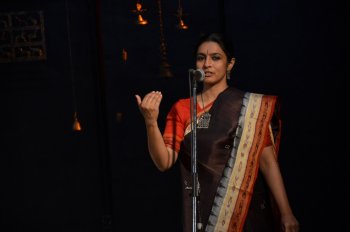 Keynote address by Parwati Dutta Needless to say that Sangeeta Ratnakara is the most important musicological text for the study of the current practices of both the Hindustani and Carnatic music traditions. Also, the text deals with dance in its seventh chapter. The first six chapters deal with the various aspects of music and musical instruments. Svaragatadhyaya, Ragavivekadhyaya, Prakirnakadhyaya, Prabandhadhyaya, Taladhyaya, and Vadyadhyaya are first six chapters, whereas Nartanadhyaya deals with dance. Often, Sangeeta Ratnakara is also known as Saptadhyayi as it is divided into seven chapters. The author Sarangadeva calls himself as Nisshanka Sarangadeva, one who has no doubts about what he has mentioned in his text. He was attached to Yadava King Singahana whose capital was Devagiri, the present Daulatabad, and now known as Aurangabad in South Maharashtra. At the time of my studies, I had only come across Dr. Kunjuni Raja and Radha Burnier's translation of the seventh adhayaya on dancing published by The Adyar Library and Research Centre (Adyar Library series vol 108, vol IV, year 1976.) The other published texts on Sangeeta Ratnakara we saw from the library of Mahagami are Dr.G.H.Tarlekar's part 3 (published by Maharashtra Rajya Sahitya ani Sanskriti Mandal with commentary of Kalanidhi, published in October 1989). Another important publication is Sangeeta Ratnakara: A study by R. Rangaramanuja Ayyangar (published by Wilco Publishing House, October 1978). Dr. Subhadra Chaudhary's Hindi translation of Sangeeta Ratnakara is also well known. The entire Sangeeta Ratnakara is not yet translated. An important seminar on Sangeeta Ratnakara was organized a few years ago at Benaras Hindu University under the guidance of Dr. Premalata Sharma at the initiative of the Central Sangeet Natak Akademi, New Delhi. The proceedings of that seminar have been published by the Akademi. 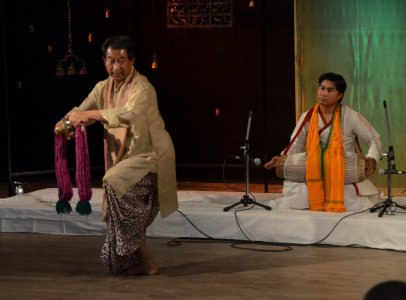 Lokendra Singh 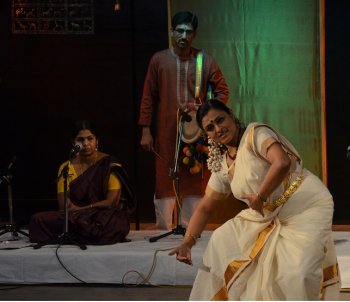 Deepti Omcherry Bhalla All this information was collected by participants during the seminar. This year the organizers had invited from Imphal's Jawaharlal Nehru Manipuri Dance Academy (JNMDA), the Manipuri artists who play pung and drums. They were led by Manipuri exponent Lokendra Singh, who gave, I am told, an excellent demonstration of Manipuri talas and movements. My flight was delayed and I missed the morning session, during which Mohiniattam talas also were demonstrated by Deepti Omcherry Bhalla from Delhi. The second day morning session was devoted to Odissi music by Pandit Gopal Chandra Panda from Bhubaneswar. He has been advocating for Odissi music as another form of classical music as are the principal two music systems, Hindustani and Carnatic. He demonstrated various aspects of rendering of Odissi music which is traditionally sung and established connections with gamakas like andolita, pallavita, ullasita, murchhita, kampita and how they are rendered in present times. Some of these are also mentioned in Sangeeta Ratnakara. Dr. Suneera Kasliwal Vyas, Professor of Music at Delhi University, was the moderator. She also compared some of these ragas with the present ragas of Hindustani music. Gopal Chandra is advanced in age and is not keeping well, but he sang songs that brought out the beauty of typical Odiya songs of Banamali and Gopalkrishna. He mentioned how in Geeta Prakasha it is said, "ado adi, ganante ekatalangi" - in the beginning adi tala and at the end of the song ekatala - and also explained what is mentioned as shuddha prabandha. I personally enjoy the sahitya of these songs and Gopal Chandra said that in his publications like Odishi Sangeeta Manjari and Odissi Ragaratnavali, he has given several examples and connections which could be found while comparing them with Sangeeta Ratnakara. He referred to ragas like raga Kolahala, the definition of it in Carnatic tradition, ragas like Madhugiri, Prathama Manjari. (Jiwan Pani and Sonal Mansingh had worked on this raga and Sonal had composed Pallavi in Prathama Manjari raga with raga lakshana shloka). According to Panda, Odissi text Geeta Prakasha is close to Sangeeta Ratnakara. It was difficult to engage him in conversation on account of his difficulty in hearing. However, his erudite observations were quite revealing. 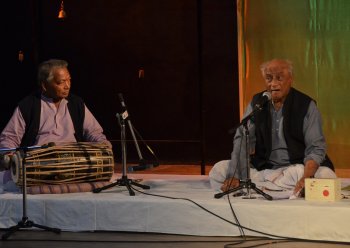 Banamali Moharana & Pt Gopal Chandra Panda 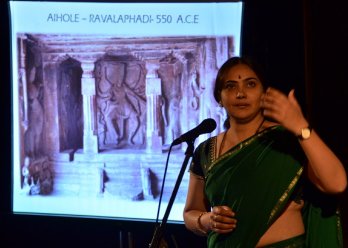 Dr. Karuna Vijayendra Dr. Karuna Vijayendra, dancer, research scholar from Bangalore, presented her power point presentation on Neo Desi Karanas and took into account desi karanas mentioned in Sangeeta Ratnakara correlating them with temple sculptures. She received guidance from Bangalore based scholar Shatavadani R Ganesh and late Guru Sundari Santhanam. She has reconstructed desi karanas and gave an example with video screening on how a dance panel was choreographed into a dance number. Her research work with her guru Sundari Santhanam has now been published in a book form 'Neo Desi Karanas' with introduction by Dr. Padma Subrahmanyam. Unfortunately, Sundari Santhanam passed away before the book was published. Karuna's approach was historical, supported by inscriptions, and several illustrations of the sculptures of various Karnataka temples. It threw light on desi karanas as they must have been in practice as mentioned in Sangeeta Ratnakara and further discovered and added to the list of those mentioned as Neo Desi Karanas. Her thesis was on 'Rangabhoga in temples of Karnataka' for which she has been awarded Ph. D by Kannada University, Hampi. Next morning, Swapnasundari expounded upon Vilasini Natyam, the form on which she has done detailed and scientific research work, recreating dance traditions of the Kalavantulus and Devadasis of Andhra region. She explained how at Sri Ranganathaswami temple in Hyderabad she has been performing regularly in February during Brahmotsavam. This is the only temple where dance is allowed to be performed as ritual and seva. The offering of nrityaseva, during Baliharanam rituals performing to ashta dikpalakas keeping Brahma in the centre, she has reconstructed the talas after the mantras are recited for each presiding deity of the eight directions. She has taken into consideration Agamas and she is performing every year at the temple with her disciple Dr. Anupama Kylash. It was a fascinating exposition by her and one got a glimpse into the creative process of Vilasini Natyam. Her book 'Vilasini Natyam' is a mine of information very systematically describing the various components of the dance form. References were made to Gondali, Perini Tandava dances which late Dr. Nataraja Ramakrishna had attempted to recreate with vigorous tandava style. Radhika from Mysore has been reconstructing Gondali nritya based on researches conducted by her and her husband Dr. Nandakumar, son of the renowned scholar R. Sathyanarayana who has been recently elected as a Fellow of the Sangeet Natak Akademi. All these attempts relate in one way or other to Sangeeta Ratnakara and various desi aspects mentioned therein. 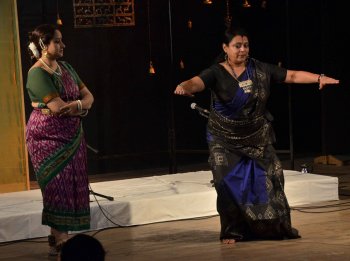 Anupama Kylash & Swapnasundari 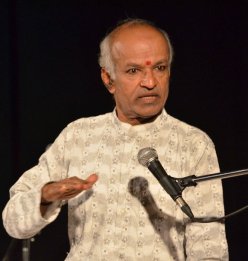 Sadanam Balakrishnan On the final day of the seminar, the celebrated Kathakali exponent Sadanam Balakrishnan from Kerala explained why Sangeeta Ratnakara was so called and not Sangeeta Arnava or Sangeeta Sagara. His studies of Sangeeta Ratnakara made him aware of the jewels, the ratnas that the author Sarangadeva has collected in his text. This was a poetic interpretation. He demonstrated in particular the upangas, various parts of the face used for expressions. The demonstrations of drishtis, eyes, which have been referred to in Sangeeta Ratnakara were quite revealing. He was hesitant to connect Kathakali with Sangeeta Ratnakara as the Sanskrit texts found in Kerala like Hastalakshanadeepika are related more to natya, theatre. Kathakali essentially is a dance drama form. But on deeper study of Sangeeta Ratnakara, he was able to see the connection between the practice in Kathakali and upangas mentioned in Sangeeta Ratnakara. The fascinating demonstration for example, was of drishti for wonderment, adbhuta for looking at something which gave delight. And then he displayed with the iris remaining in the same position and wonderment at the vision of the divine. The subtle differences were breathtaking. He did mention that sometimes sringara for vipralambha, in separation comes closer to karuna. Swapnasundari asked a pertinent question about how the musicians understand when the dancers wish to start manodharma, imaginative improvisation on the spot and how do they coordinate. Guruji explained how with certain hand and arm movement it is conveyed though they are at the back. Besides relation with Sangeeta Ratnakara, the demonstration brought to the notice of the audience the wealth of practice of Kathakali, in terms of pure dance and expressions. Dr. Suneera Kasliwal Vyas in her presentation showed various instruments of Rajasthan. She also shared the research work undertaken by her on Rajasthani musicians and Langha and Manganiyar. Parwati Dutta had succeeded in bringing a group of Manganiyars from a village near Barmer with the help of West Zonal Cultural Centre. Led by Loonakhan, they regaled us with their full throated singing, the musicians playing harmonium, dholak, khadtal (kartala), kamancha and an earthen pot, which none of us had seen. Suneera showed the photograph of a musician holding it near the mouth and blowing breath in it, creating an amazing sound. Various types of instruments, string instrument, ektantri veena, special one Manganiyar musicians use like kamancha, closer to sarangi, some instruments mentioned in musical text Radhagovindasangeetasara found in Rajasthan, flutes, two flutes- pava jodi, and so on - a wealth of information was given by her in a lucid manner. The previous evening, the Manganiyar musicians entertained the audience with their folk songs, mentioning ragas like Shyam Kalyan, Mand, Desh, Paraj, Hichki, Bhairavi. The musicians have now earned international fame. It was Komal Kothari, a musicologist and expert on folk culture of Rajasthan who had discovered them and brought them to the notice of the urban area. They are Muslims and live in different parts of Rajasthan, but mainly near Barmer, Jaisalmer. They have their patrons who support them. Those talented in singing learn music as they grow up listening to elders and it is an oral tradition. Some specialize in playing kamancha, some in khadtal, and some in dholak, as well as using earthen pot, blowing in its mouth and creating amazing sound textures. Their songs by now are very popular. "Maro gorbandh nakharalo," "Nimbuda nimbuda," "Mast kalandar" have now become extremely popular. Suneera requested them to sing one on "Moralo," peacock. I requested them to render one Rajasthani folk song I had heard way back in 1958 in Udaipur, "Mara chhel bhavanra ro kangasiya panihariyan le gayi re." The musicians sang lustily and charmed us all with their singing. They were performing in Aurangabad for the first time. Suneera explained their musical tradition and folk songs with ragas as performed and practiced by them. 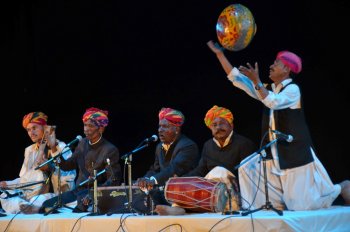 Manganiyars 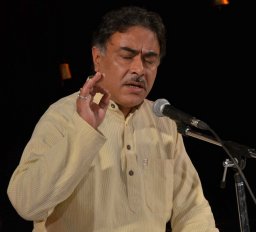 Nirmalya Dey Nirmalya Dey, Dhrupad singer from Delhi gave in brief, an excellent account of Dhrupad singing, the bandishes of Tansen, explaining various types of Dhrupad banis. Compositions of Tansen like 'Raja Govarhar, Faujdar Khandar, Deewan Dagur aur Bakshi Naugharhar' described the banis. A versatile musician and scholar, he brought to our knowledge a fund of information on Dhrupad singing. The seminar was very educative. I have suggested to Parwati Dutta to get the discussions which are recorded to be edited and brought out in a book form. Not only the present one, but also earlier seminars, so that it can be made accessible to scholars. I also feel that with institutions like Indira Gandhi National Centre for the Arts (IGNCA) and Sangeet Natak Akademi (SNA) in Delhi, a seminar on Sangeeta Ratnakara should be held in Delhi for serious exposition of these margi and desi aspects of both dance and music. Dance Festival This year, the dance festival was held at the Rukmini Sabhagriha of Mahatma Gandhi Mission, next to Mahagami Gurukul. The response was encouraging. Though some were being exposed to some forms for the first time, the appreciation was palpable and every day one saw them attending till the performances were over. From Lucknow, Bhatkhande Vidyapeeth's Kathak exponent Dr. Richa, a disciple of Dr. Purnima Pande gave glimpses of Lucknow gharana Kathak and a few rare compositions which Purnima Pande had studied from Kathak exponent and scholar Mohanrao Kallianpurkar. I had seen her at Pune during Mohanrao's centenary celebrations. Richa has attractive stage presence and wearing the white costume as well as hair ornament like chhappa, as seen in Mughal miniature paintings, she displayed the 'Lucknowi mijaj' of a bygone era. Her parans, tode, tukde, chakkardar, ladi, uthan, thaat were graceful. However, she should have explained the ghazal of Wajid Ali Shah to which she performed abhinaya, for better appreciation. It would have been also interesting if she had shown more upaj ang, imaginative interpretation for the text of the ghazal. The two other young students who performed were rather immature and did not show the refinement of Lucknow gharana. They also needed proper guidance when they danced duet. Deepti Omchery Bhalla's Mohiniattam was flawless. Her damaru natyam to the typical Kerala talas was performed with such engagement and intensity that she won rounds of applause for that specially choreographed number. The accompaniment on edakka was impressive. The performance of her two disciples was also noteworthy, as Deepti has trained them well. Mohiniattam as a form has been enriched by Deepti in terms of talas with her deep study. 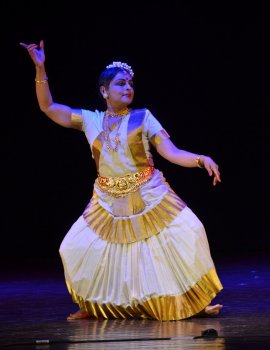 Deepti Omchery Bhalla 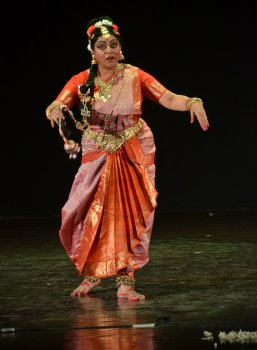 Swapnasundari 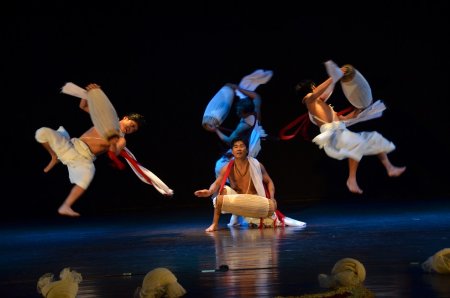 Pung cholom by Manpuri dancers On second day after Nirmalya Dey's Dhrupad singing, Swapnasundari along with her disciple Anupama Kylash performed Vilasini Natyam showing the ritualistic aspect of Baliharanam and offering flowers to the eight deities of the eight directions. Both of them showed this dance form with its salient features, as reconstructed by Swapnasundari. Swapna's exposition of Navajanardhana Parijata dwelling upon Satyabhama's patrapravesha was devastating in terms of Satyabhama's supreme confidence as swadhinapatika nayika, in full form, describing her physical beauty, in which the upama, simile for each part of her body was danced with brilliant perfection. The crescent moon, the lotus, the banana trunk et al compared to her physical parts paled into insignificance. With captivating swagger she walked with admirable arrogance! When she performed abhinaya to "Ravaiyya madana mohana" inviting Krishna, she took some of the Dasavatara sequences and said to Krishna: "Come unto me, I shall offer you great pleasure. Why do you have to kill as Parashurama the kshatriyas? Instead come, we shall play rasalila" and so on. Each incarnation, with amazing comparison, surprised some of us for her imaginative improvisation. No wonder, she has acquired fame as an excellent abhinaya exponent. The gradual exposition of Navajanaradhana Parijata was utterly charming. Her own singing lent extra charm to the exposition. Since the artist had to conclude her program within the allotted time, she succeeded in keeping audiences hungry, wanting to see more of her dance. I suggested to Parwati Dutta to arrange a 'Swapnasundari prasanga' in Aurangabad, when her students and the rasikas, shall get an opportunity to relish the art of Swapnasundari. Recently, I had an opportunity to watch her performance at Krishna Gana Sabha in December in Chennai, when she received the Nritya Choodamani award for Vilasini Natyam from the sabha. Needless to say, she had the audience eating out of her hand. 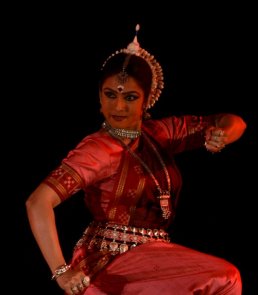 Parwati Dutta 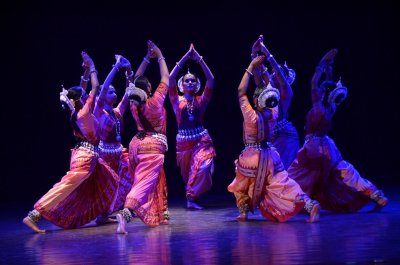 Vadya Pallavi The final number by Parwati Dutta and her troupe was Vadya Pallavi to the accompaniment of six mardala players. This exploration by Parwati Dutta under the guidance of Guru Banamali Maharana, the great exponent of mardala and pakhavaj from Bhubaneswar, is a feather in the cap of Parwati. Her desire to seek confirmation from the traditional gurus and expand the repertoire of Odissi, creating Vadya Pallavi needs to be seen in various dance conferences. Set to Bihagda, Dhrupadangi raga and exploring various talas, with aposite nritta, Parawati and her troupe performed this unique number with confidence. The six pakhavaj players had to maintain the perfect sound and also the complex talas to reveal the exploration as well as its beauty. Though at times one felt that Parwati and her students need to maintain the udvahita movement of the chest in Odissi style more clearly, the overall impression was praiseworthy. The replacement of khol in one sequence to the mnemonic tini tini was to suggest the rasalila aspect. One saw these few subtle elements sitting next to Guru Banamali Maharana, who explained the complexities of Vadya Pallavi. For the finale, Parwati has used Dhammapada prayer which also looked novel. Such innovations and explorations are most welcome and one was pleased to see these explorations as they expand the horizons of Odissi dance and music.  Sadanam Balakrishnan She tells of her pathetic state to Bhima who promises her to kill Keechaka. As planned she tells Keechaka to come to a secret place around midnight. In the dark, Keechaka sees a figure sleeping under the sheets. He touches the figure and is shocked that the arms are hard as a rock. He wonders if perhaps he had bitten Draupadi, therefore the body had turned hard. After his advances, Bhima grips him in a tight embrace till he dies. Keechaka breathes his last and his head falls on Bhima's shoulder. That scene of Keechaka's dying enacted by Guru Sadanam Balakrishnan shall remain in one's memory for a long time. Also cholliyattam, improvisation to the accompanying music and no text being sung, was captivating when Keechaka runs after Draupadi in the opening scene. Kathakali even when presented in an abbreviated form with entry point of commentary in Hindi as it was done and English sur-titles helps audience to understand what is happening on the stage. Once a spectator is 'bitten by the bug,' he turns into 'a Kathakalibhrantan,' a Kathakali aficionado. Parwati Dutta's attempt to bring Kathakali to Aurangabad audience is praiseworthy. Indeed, it was heartening to see the audience give a rousing applause to the artists at the end of the performance.  Dr. Sunil Kothari is a dance historian, scholar, author and a renowned dance critic. He is Vice President of World Dance Alliance Asia Pacific India chapter, based in New Delhi. He is honored by the President of India with Padma Shri, Sangeet Natak Akademi award and Senior Critic Award from Dance Critics Association, NYC. He is a regular contributor to www.narthaki.com, the roving critic for monthly magazine Sruti and is a contributing editor of Nartanam for the past 12 years. Post your comments Pl provide your name and email id along with your comment. All appropriate comments posted with name and email id in the blog will also be featured in the site. |